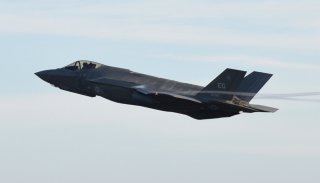The F-35’s Cyber Reliance Makes It Powerful—But Also Vulnerable to Attack
This kind of cyber-reliant modernization trajectory for the F-35, intended to ensure the stealth jet retains its performance edge well into the 2070s and beyond, also needs to ensure that computer systems are sufficiently “hardened” against cyberattacks and intruders.
Identifying a Chinese or Russian fifth-generation fighter jet from safe stand-off ranges; ensuring a smooth and successful “glide slope” landing onto a carrier deck; merging otherwise disparate pools of information into a single organized, integrated picture for pilots; and quickly integrating new, paradigm-changing weapons are all capabilities now fundamental to the operation of the F-35 Joint Strike Fighter.
These factors help explain why the F-35 is often referred to as a “flying computer,” alongside being more generally known as a high-speed, stealthy, and maneuverable multi-role attack fighter. Much, if not most, of the jet’s advanced performance is made possible by advanced computing, something easily overlooked or even eclipsed by the jet's other more visible and well-known attributes.
While many F-35 missions and operations directly pertain to a “kinetic” kill, attack, or combat engagement, they are all largely enabled by computer technology.
The jet’s well-known “sensor fusion,” which relies upon an advanced, artificial intelligence-like ability to gather, distill, integrate, and present vast amounts of otherwise overwhelming data, is enabled by computing. This means infrared and electro-optical/infra-red sensor data, navigational and terrain specifics, weapons guidance technology, and even electronic warfare information are all compiled, analyzed in relation to one another, and presented to pilots in an integrated single picture. The F-35’s computing also enables its sensors to complete rapid threat identification and attack planning at safer, undetected, stand-off ranges by bouncing incoming data off of its Mission Data Files database library which catalogs known threats.
The F-35’s computing power also brings the fighter jet’s crucial “software drop” updates to fruition, an incremental upgrade process that continuously adds new weapons interfaces, improved sensing, and high-speed AI-enabled information processing. The “fourth” software drop, for example, integrates the Stormbreaker bomb into the jet, introducing unprecedented attack ranges up to 40 nautical miles, course-correcting two-way datalinks, and all-weather targeting technology.
Computing also plays a key role when it comes to precision targeting as software upgrades can, in many cases, improve air-to-air and air-to-ground weapons performance. This is particularly true in the case of the F-35’s AIM-120 and AIM-9X weapons, which have received flight path and guidance technology enhancements through the integration of new software.
Much of this evolving process or ongoing iteration of software upgrades to ensure continuous modernization is made possible through the use of common technical standards. Often referred to as “open architecture,” the intent is to engineer a system with interoperable IP Protocol standards such that new technologies can be quickly integrated without needing to essentially “re-construct” the aircraft’s computing infrastructure.
This kind of cyber-reliant modernization trajectory for the F-35, intended to ensure the stealth jet retains its performance edge well into the 2070s and beyond, also needs to ensure that computer systems are sufficiently “hardened” against cyberattacks and intruders. While all of the F-35’s advanced computing is bringing unparalleled and potentially breakthrough systems to war in unanticipated ways, added computer networking can also introduce new vulnerabilities. For example, what are the consequences if an F-35’s computer was somehow “hacked,” derailed, denied service, or simply fed wrong information? Pilots could be fed incorrect targets or given erroneous navigational details. Also of great concern is whether weapons targeting could be compromised as well.
Throughout all weapons systems, including the F-35, the advantages and challenges of increased computer reliability could be described as a dual-pronged phenomenon. Increased computer modernization, data sharing, and pooled or organized streams of information can potentially increase vulnerability. Are the unprecedented advantages afforded by advancing computing and software upgrades offset by an increased susceptibility to cyberattack? Greater networking of combat nodes means an intruder could exact a large impact upon multiple systems by merely penetrating or compromising one platform, node, or point of entry.
The need to safeguard F-35 computing is something that has been on the radar at the Pentagon for many years now. Interestingly, as far back as 2016, the Air Force was working intensely upon the need to “bake-in” cyber protections and resilience early in the developmental process of new weapons systems and emerging technologies. Former Air Force chief information security officer Peter Kim cited the F-35 fighter in 2016 as a key example of how cybersecurity priorities and technologies needed to expand well beyond the realm of information technology (IT) to incorporate large weapons systems. Speaking at an Armed Forces Communications and Electronics Association event in December, Kim specifically cited the F-35 in saying that “we need to focus on cyber defense and cybersecurity beyond what we have traditionally done. Threats are changing, so how do we approach the domain of cyberspace beyond what we are thinking about with IT?”
Kris Osborn is the defense editor for the National Interest. Osborn previously served at the Pentagon as a Highly Qualified Expert with the Office of the Assistant Secretary of the Army—Acquisition, Logistics & Technology. Osborn has also worked as an anchor and on-air military specialist at national TV networks. He has appeared as a guest military expert on Fox News, MSNBC, The Military Channel, and The History Channel. He also has a Master’s Degree in Comparative Literature from Columbia University.
Image: Air Force Flickr.

